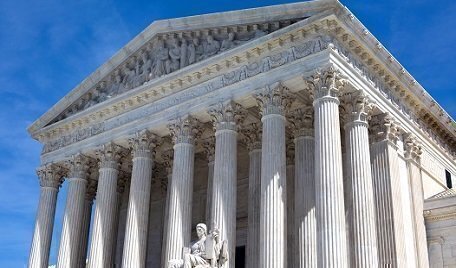Giving the Trump Administration its second major victory in recent months for a highly controversial public policy, a deeply divided Supreme Court on Tuesday cleared the way for enforcement of a far-reaching restriction on military service by transgender people.
 While only temporary, the Court’s permission – given on two 5-to-4 votes -- can last for many months because the issue of the validity of the policy will not return to the Justices at least until the next term, which starts in October. The Court explicitly refused to speed up its review on the legality of the policy, doing so in three separate cases, thus leaving that question for the time being with federal courts of appeals.
While only temporary, the Court’s permission – given on two 5-to-4 votes -- can last for many months because the issue of the validity of the policy will not return to the Justices at least until the next term, which starts in October. The Court explicitly refused to speed up its review on the legality of the policy, doing so in three separate cases, thus leaving that question for the time being with federal courts of appeals.
In a series of orders, the Justices set aside temporarily two nationwide orders against enforcement which had been issued by lower federal courts. Three federal trial judges had forbidden enforcement, but one of those was temporarily set aside by a federal appeals court earlier this month.
The Justices acted seven months after handing a more sweeping victory to President Trump and his government in a decision last June upholding a broad ban on entry into the U.S. of travelers from a group of nations with Muslim-dominated populations.
That ban, like the restriction on transgender servicemembers, originated with the President himself. Each policy then got translated into specific outlines by government agencies.
The Trump policy that was cleared temporarily on Tuesday had begun with a presidential tweet, casting aside an Obama Administration policy that allowed transgender individuals to serve openly in the military, living their lives in the ranks in the gender with which they now identify, not the one assigned to them at birth.
While not a total ban on military life for transgender individuals, the Trump policy as it currently stands will only allow such service (with a narrow exception) if the person does not insist on serving in the gender role with which they identify. In other words, they may enlist or continue to serve only in the gender identity assigned to them at birth – which, by definition, a transgender person no longer accepts.
While the Pentagon and Administration lawyers have argued that the policy is only aimed at persons who are diagnosed with a medical condition (“gender dysphoria”), lawyers and advocacy groups challenging the policy have countered that is not based on that condition at all but on the mere fact that an individual is transgender.
In stopping enforcement of that policy while test cases continued in lower courts, federal trial judges ruled that the Pentagon had not justified switching away from the Obama version of open service and ruled that the policy would harm transgender individuals already serving in uniform, and would discriminate against transgender persons seeking to enlist.
Rather than waiting for federal appeals courts to rule in any way, the Trump Administration initially asked the Justices to grant review of the legality of the policy, bypassing the usual appeals route. Later, the Administration urged the Justices, if they were unwilling to grant speedier review, at least to allow enforcement of the policy in the meantime. That is just what the Court did Tuesday.
The resulting orders allowing enforcement without any limits on the scope of the policy drew the support of Chief Justice John G. Roberts, Jr., and Justices Samuel A. Alito, Jr., Neil M. Gorsuch, Brett M. Kavanaugh and Clarence Thomas.
Their votes were not shown in the orders, but it took the votes of five Justices to lift the trial judges’ orders against enforcement and four Justices did note publicly that they were dissenting. Voting in dissent were Justices Stephen G. Breyer, Ruth Bader Ginsburg, Elena Kagan and Sonia Sotomayor. Thus, the split was between the Court’s more conservative Justices, forming the majority, and more liberal Justices, in dissent.
The two main orders said that enforcement could continue while review of the policy continues in the federal appeals courts. If the appeals courts’ rulings go against the government, if the government appeals, and if the Supreme Court then grants full review, the enforcement can continue in the meantime. If future government appeals were denied review, then enforcement would have to stop, according to the orders.
One factor that the Court always takes into account when deciding whether to set aside an order that has been issued by a lower court is whether the party that lost in the lower courts – the government, in the transgender cases – has a good chance of winning when the legality is finally decided. Thus, Tuesday’s orders were an encouraging sign for the Trump Administration.
Lyle Denniston has been writing about the Supreme Court since 1958. His work has appeared here since mid-2011.







